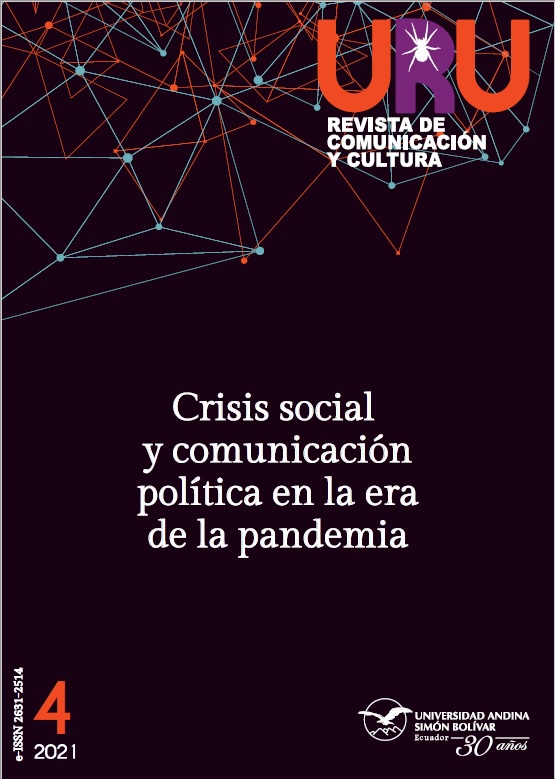Marketing de prensa en tiempos de COVID-19: Comparativa de los patrones de consumo de prensa nativa y digital
DOI:
https://doi.org/10.32719/26312514.2021.4.6Palabras clave:
marketing, prensa, Ecuador, COVID-19, comportamiento del consumidorResumen
El contexto de excepcionalidad que ha provocado el COVID-19 ha tenido consecuencias en la prensa de todo el mundo. El confinamiento ha visto crecer el hábito de leer la prensa en su versión digital. Esta situación permite formular muchas preguntas en torno al futuro de las tiradas en papel y el tipo de consumo informativo pospandemia. En este sentido, se ha llevado a cabo una investigación aproximativa, enmarcada en el ámbito de Ecuador, con el objetivo de identificar patrones de comportamiento de los consumidores de productos informativos a través de ediciones digitales que permitan determinar las bases de un nuevo modelo de acceso a y consumo de este tipo de medios, que todavía, en el espacio sociogeográfico estudiado, se encuentra en una fase inicial de transformación. Esta cuestión constituye uno de los principales aportes de la investigación, pues no puede obviarse la sensibilidad de países como Ecuador a la incidencia de crisis sanitarias o catástrofes naturales, en que el acceso a la información es esencial. La investigación se ha llevado a cabo en el momento más crítico de la pandemia, por suponer un punto de inflexión en el consumo habitual de periódicos. Se ha analizado la evolución de indicadores de relevancia para los modelos digitales de negocios, como el engagement de diecisiete diarios ecuatorianos durante los meses prepandemia (febrero) y confinamiento (marzo a mayo).
Descargas
Referencias
Andreu, Celia, y Miguel Ángel Martín. 2020. “Fake Images of the SARS-CoV-2 Coronavirus in the Communication of Information at the Beginning of the First COVID-19 Pandemic”. El Profesional de la Información 29 (3). https://doi.org/10.3145/epi.2020.may.09.
APM. 2020. “Aparecen algunos síntomas de saturación informativa en el consumo de medios durante el confinamiento”. Asociación de la Prensa de Madrid. 29 de abril.
https://bit.l/2SKDpN6.
Bravo, J., C. Larrea, y R. Ruales. 2020. “Tratamiento del COVID-19: Ecuador mediante el humor periodístico”. Brazilian Journal of Health Review 3 (2): 3523-41.
CAF. 2020. “El estado de la digitalización de América Latina frente a la pandemia del COVID-19”. Banco de Desarrollo de América Latina. https://bit.ly/2RXWfQK.
Cairo, H. 2020. “Geopolítica popular del coronavirus: El poder de las viñetas editoriales de la prensa diaria”. Geopolítica(s) 11: 303-17.
Casero Ripollés, Andreu. 2020a. “Impact of COVID-19 on the Media System. Communicative and Democratic Consequences of News Consumption during the Outbreak”. El Profesional de la Información 29 (2). https://doi.org/10.3145/epi.2020.mar.23.
—. 2020b. “Influence of Media on the Political Conversation on Twitter: Activity, Popularity, and Authority in the Digital Debate in Spain”. Icono14 18 (1): 33-57.
https://doi.org/10.7195/ri14.v18i1.1527.
Chen, Q., C. Min, W. Zhang, G. Wang, X. Ma, y R. Evans. 2020. “Unpacking the Black Box: How to Promote Citizen Engagement through Government Social Media during the COVID-19 Crisis”. Computers in Human Behavior 110. https://bit.ly/34yHbM1.
Cobarsí, Josep. 2020. “COVID-19: Fuentes de información cuantitativa”. Anuario ThinkEPI 14. https://doi.org/10.3145/thinkepi.2020.e14d02.
Costa, Carmen, Ana Rodríguez, y Xosé López. 2015. “Del periodismo transmedia al replicante. Cobertura informativa del contagio de ébola en España por Elpais.com”. El Profesional de la
Información 24 (3): 282-90.
Dabbagh, A. 2020. “The Role of Instagram in Public Health Education in COVID-19 in Iran”. Journal of Clinical Anesthesia 65. https://bit.ly/3vDV9Z3.
Igartua, Juan José, Félix Ortega, y Carlos Arcila. 2020. “Communication use in the times of the coronavirus. A cross-cultural study”. El Profesional de la Información 29 (3).
Jiménez, M. R., C. Gómez, y E. Soto. 2020. “Coronavirus, Ageism, and Twitter: An Evaluation of Tweets about Older Adults and COVID-19”. The American Geriatrics Society 68: 1661-5.
Lázaro, Pedro, y Enrique Herrera. 2020. “Noticias sobre COVID-19 y 2019-nCoV en medios de comunicación de España: El papel de los medios digitales en tiempos de confinamiento”.
El Profesional de la Información 29 (3).
Descargas
Publicado
Cómo citar
Número
Sección
Licencia
Los autores/as que publiquen en esta revista aceptan las siguientes condiciones:
- Los autores/as conservan los derechos de autor y ceden a la revista el derecho de la primera publicación, con el trabajo registrado bajo Licencia Creative Commons 4.0 de Reconocimiento No Comercial-Compartir Igual 4.0, que habilita a compartir, adaptar y atribuir el trabajo (ver: Políticas de acceso abierto).
- Los autores/as pueden realizar otros acuerdos contractuales independientes y adicionales para la distribución del artículo publicado en esta revista (p. ej., incluirlo en un repositorio institucional o publicarlo en un libro) siempre y cuando indiquen claramente que el trabajo se publicó por primera vez en Uru. En caso de reproducción deberá constar una nota similar a la siguiente: Este texto se publicó originalmente en Uru: Revista de Comunicación y Cultura N° --, año de publicación.
- Se recomienda a los autores/as publicar su trabajo en Internet (por ejemplo en páginas institucionales o personales) en la versión final publicada por Uru: Revista de Comunicaicón y Cultura ya que puede conducir a una mayor y más rápida difusión del trabajo publicado.









